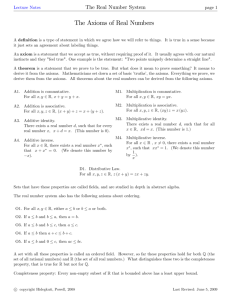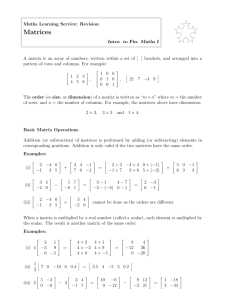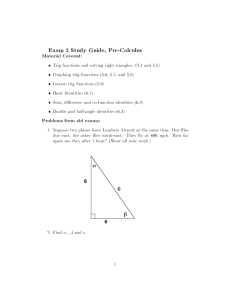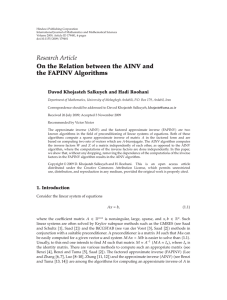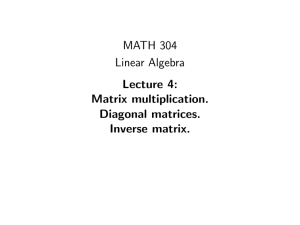Ann. Funct. Anal. 3 (2012), no. 2, 115–127
advertisement
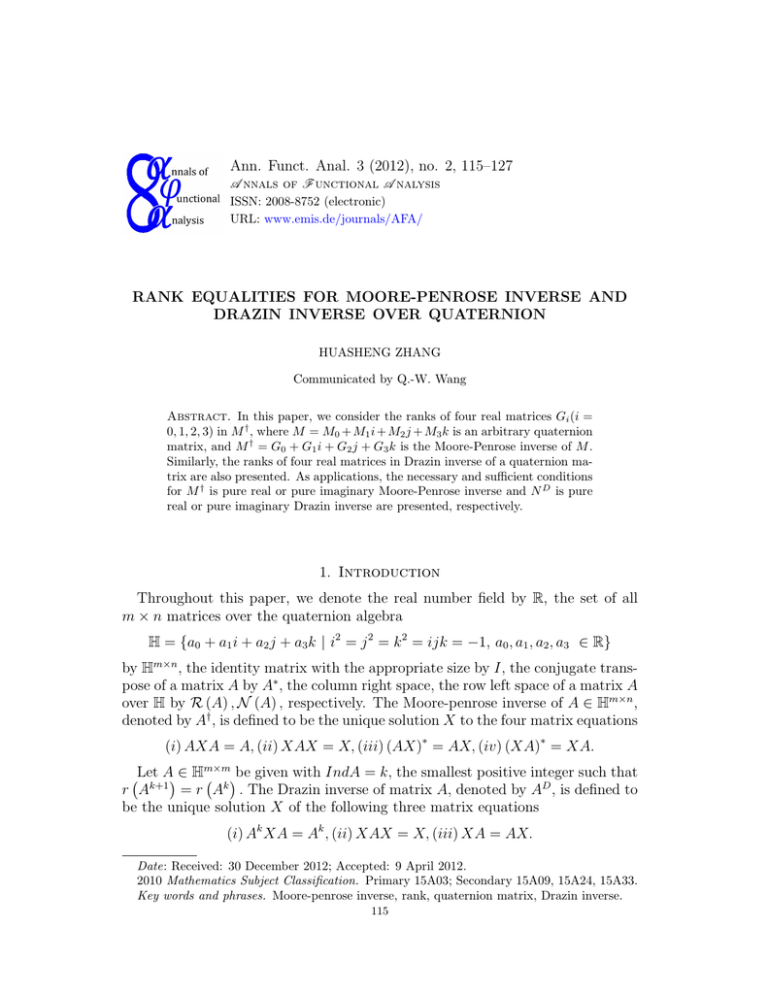
Ann. Funct. Anal. 3 (2012), no. 2, 115–127
A nnals of F unctional A nalysis
ISSN: 2008-8752 (electronic)
URL: www.emis.de/journals/AFA/
RANK EQUALITIES FOR MOORE-PENROSE INVERSE AND
DRAZIN INVERSE OVER QUATERNION
HUASHENG ZHANG
Communicated by Q.-W. Wang
Abstract. In this paper, we consider the ranks of four real matrices Gi (i =
0, 1, 2, 3) in M † , where M = M0 + M1 i + M2 j + M3 k is an arbitrary quaternion
matrix, and M † = G0 + G1 i + G2 j + G3 k is the Moore-Penrose inverse of M .
Similarly, the ranks of four real matrices in Drazin inverse of a quaternion matrix are also presented. As applications, the necessary and sufficient conditions
for M † is pure real or pure imaginary Moore-Penrose inverse and N D is pure
real or pure imaginary Drazin inverse are presented, respectively.
1. Introduction
Throughout this paper, we denote the real number field by R, the set of all
m × n matrices over the quaternion algebra
H = {a0 + a1 i + a2 j + a3 k | i2 = j 2 = k 2 = ijk = −1, a0 , a1 , a2 , a3 ∈ R}
by Hm×n , the identity matrix with the appropriate size by I, the conjugate transpose of a matrix A by A∗ , the column right space, the row left space of a matrix A
over H by R (A) , N (A) , respectively. The Moore-penrose inverse of A ∈ Hm×n ,
denoted by A† , is defined to be the unique solution X to the four matrix equations
(i) AXA = A, (ii) XAX = X, (iii) (AX)∗ = AX, (iv) (XA)∗ = XA.
Let A ∈ Hm×mbe given with IndA = k, the smallest positive integer such that
r Ak+1 = r Ak . The Drazin inverse of matrix A, denoted by AD , is defined to
be the unique solution X of the following three matrix equations
(i) Ak XA = Ak , (ii) XAX = X, (iii) XA = AX.
Date: Received: 30 December 2012; Accepted: 9 April 2012.
2010 Mathematics Subject Classification. Primary 15A03; Secondary 15A09, 15A24, 15A33.
Key words and phrases. Moore-penrose inverse, rank, quaternion matrix, Drazin inverse.
115
116
H. ZHANG
Suppose
M = M0 + M1 i + M2 j + M3 k, N = N0 + N1 i + N2 j + N3 k
(1.1)
be a quaternion matrix, where Mi ∈ Rm×n , Ni ∈ Rm×m , i = 0, 1, 2, 3, and let
M0 −M1 −M2 −M3
N0 −N1 −N2 −N3
M1 M0
M3 −M2
N3 −N2
, N = N1 N0
,
M =
M2 −M3 M0
N2 −N3 N0
M1
N1
M3 M2 −M1 M0
N3 N2 −N1 N0
(1.2)
and the Moore-Penrose inverse of M, the Drazin inverse of N are denoted by
M † = G0 + G1 i + G2 j + G3 k, N D = D0 + D1 i + D2 j + D3 k,
(1.3)
respectively, where Gi ∈ Rn×m , Di ∈ Rm×m , i = 0, 1, 2, 3.
Moore-Penrose inverse of matrix is an attractive topic in matrix theory and
have extensively been investigated by many authors (see, e.g., [1]-[11]). Drazin
inverse is also one of the important types of generalized inverses of matrices,
and have well been examined in the literatures, (see, e.g., [1]-[2], [13]-[16]). For
example, Campbell and Meyer gave a basic identity on Drazin inverse of a matrix
in [1]
†
AD = Ak A2k+1 Ak .
(1.4)
L. Zhang presented a characterization of the Drazin inverse of any n×n singular
matrix and proposed a method for solving the Drazin inverse and an algorithm
with detailed steps to compute the Drazin inverse in [13].
As well known, the expressions of Gi , Di (i = 0, 1, 2, 3) in M † , N D are quite
complicated if there are no restrictions (see, e.g., [3], [5]). In that case, it is
difficult to find properties of Gi , Di (i = 0, 1, 2, 3) in M † , N D . In this paper, we
derived the ranks of Gi , Di (i = 0, 1, 2, 3) in M † , N D through a simpler method,
and then give some interesting consequences.
As a continuation of the above works, we in this paper investigate the ranks
of real matrices Gi , Di (i = 0, 1, 2, 3) in M † and N D . In Section 2, we derive
the formulas of rank equalities of four real matrices G0 , G1 , G2 and G3 in M † =
G0 + G1 i + G2 j + G3 k. Moreover, we established the necessary and sufficient
conditions for M † is pure real or pure imaginary Moore-Penrose inverse. In
Section 3, the formulas of rank equalities of four real matrices D0 , D1 , D2 and D3
in N D = D0 + D1 i + D2 j + D3 k are established, and the necessary and sufficient
conditions for N D is pure real or pure imaginary Drazin inverse are presented.
Some further research topics related to this paper are also given.
2. Rank equality for Gi (i = 0, 1, 2, 3) in M †
We begin with the following lemmas which can be generalized to H.
Lemma 2.1. (see [6]) Let A1 , A2 , · · · , Ak ∈ Hm×n . Then the Moore-Penrose inverse of their sum satisfies
RANK FOR M-P INVERSE AND DRAZIN INVERSE
117
†
· · · Ak
Im
· · · Ak−1 Im
. .
..
..
.
. ..
· · · A1
Im
A1 A2
A
1
k A1
(A1 + A2 + · · · + Ak )† = [In , In , · · · In ]
.
..
..
k
.
A2 A3
Lemma 2.2. (see [6]) Let A1 , A2 , · · · , Ak ∈ Hm×n . Then the Drazin inverse of
their sum satisfies
D
· · · Ak
Im
· · · Ak−1 Im
.
..
..
..
.
.
· · · A1
Im
A1 A2
Ak A1
1
(A1 + A2 + · · · + Ak )D = [In , In , · · · In ]
..
...
k
.
A2 A3
.
Lemma 2.3. (see [7]) Let A ∈ Hm×n , B ∈ Hm×k , C ∈ Hl×n and D ∈ Hl×k be
given. Then the rank of the Schur complement S = D−CA† B satisfies the equality
†
r D − CA B = r
A∗ AA∗ A∗ B
CA∗
D
−r (A) .
(2.1)
Lemma 2.4. (see [8]) Let A ∈ Hm×n , B ∈ Hm×k and C ∈ Hl×n be given, and
suppose that
R (AQ) = R (A) , R [(P A)∗ ] = R (A∗ ) .
Then
r [AQ, B] = r [A, B] , r
PA
C
=r
A
C
.
where P and Q are arbitrary matrices over H.
Now we establish the main result about Moore-Penrose inverse.
Theorem 2.5. Let M, M and M + be
ranks of Gi (i = 0, 1, 2, 3) in (1.3) can
"
#
c0 M
f0
M
r (G0 ) = r
−r M ,
f 0
M
"
#
c
f
M2 M2
r (G2 ) = r
−r M ,
f 0
M
given by (1.1), (1.2) and (1.3). Then the
be determined by the following formulas
"
#
c1 M
f1
M
r (G1 ) = r
−r M ,
(2.2)
f 0
M
"
#
c
f
M3 M3
r (G3 ) = r
−r M ,
(2.3)
f 0
M
where
c0
M
∗
−M1 −M2 −M3
∗
∗
∗
M
−M
M
M
M
M
−M
1
0
3
2
0
3
2
M0
M3 −M2
∗
∗
M3∗
M
−M
M2 −M3 M0
M1 ,
=
0
1
−M3 M0
M1
∗
∗
∗
−M2 M1
M0
M3 M2 −M1 M0
M2 −M1 M0
118
H. ZHANG
∗
M0 −M2 −M3
∗
∗
∗
M
M
M
−M
M
M
M
1
0
3
2
1
2
3
c1 = M1 M3 −M2 M3∗ M0∗ −M1∗ M2 −M3 M0
M1 ,
M
M2 M0
M1
∗
∗
∗
−M2 M1 M0
M3 M2 −M1 M0
M3 −M1 M0
∗
M0 −M1 −M3
∗
∗
∗
M
M
M
−M
M
M
M
1
0
3
2
3
2
1
c2 = M1 M0 −M2 M0∗ −M3∗ M2∗ M2 −M3 M0
M1 ,
M
M2 −M3 M1
∗
∗
∗
−M2 M1 M0
M3 M2 −M1 M0
M3 M2
M0
∗
M0 −M1 −M2 ∗
M1 M0
M3 −M2
M3∗
M1 M2∗
M1 M0
M3 ∗
∗
∗
c3 =
M2 −M3 M0
M1 ,
M
M2 −M3 M0 M0∗ −M∗3 M2 ∗
M3 M2 −M1 M0
M3 M0 −M1
M3 M2 −M1
M0
−M1
M1
M0
f0 =
f
M
M2 , M1 = −M3
M3
M2
−M2
−M3
M3
−M2
f2 =
,M
f
M0 , M3 = M1
−M1
M0
,
and
f = [M0 , −M1 , −M2 , −M3 ] .
M
Proof. According to Lemma 1, we have
(M0 + M1 i + M2 j + M3 k)†
†
Im
M0 M1 i M2 j M3 k
M1 i M0 M3 k M2 j Im
1
= [In , In , In , In ]
M2 j M3 k M0 M1 i Im
4
Im
M3 k M2 j M1 i M0
†
M0 −M1 −M2 −M3
Im
M1 M0
1
M3 −M2
−iIm
= [Im , iIm , jIm , kIm ]
M2 −M3 M0
M1 −jIm
4
M3 M2 −M1 M0
−kIm
G0 −G1 −G2 −G3
Im
G1 G0
1
G3 −G2
−iIm .
= [Im , iIm , jIm , kIm ]
G2 −G3 G0
G1 −jIm
4
G3 G2 −G1 G0
−kIm
Obviously, G0 can be written as
Im
† 0
†
G0 = [In , 0, 0, 0] M
0 = P M Q,
0
(2.4)
RANK FOR M-P INVERSE AND DRAZIN INVERSE
119
where
Im
0
P = [Im , 0, 0, 0] , Q =
0 .
0
Then it follows by Lemma 2, Lemma 3, (1.4) and (2.4) we get
∗
∗
∗
M MM M Q
r (G0 ) =
−r M
∗
PM
0
∗
MM M MP ∗
−r M
=
∗
QM
0
M0 −M1 −M2 −M3
M0 −M1 −M2 −M3
M1 M0
∗
M
M0
M3 −M2
M
−M
1
3
2
M
M2 −M3 M0
M1
M1
= M2 −M3 M0
M3 M2 −M1 M0
M
M
−M
M0
3
2
1
M0 −M1 −M2 −M3
−r M
M0
M1
M2
M3
0
0
0
0
0
0 −M1 −M2 −M3
0 M0
M3 −M2
M3 −M2 ∗ M1 M0
M
0 −M3 M0
M
−M
M
M1
M
=
2
3
0
1
0 M2 −M1 M0
M3 M2 −M1 M0
M0 −M1 −M2 −M3
−r M
−M1 −M2 −M3
M1 M0
M3 −M2
M0
M3 −M2 ∗
M2 −M3 M0
M1
M
−M3 M0
M1
=
M3 M2 −M1 M0
M2 −M1 M0
M0 −M1 −M2 −M3
M0
M1
M2
M3
0
M0
M1
M2
M3
0
−r M
which is the first equality in (2.2). The other equalities (2.2) and (2.3) can also
be derived by the similar approach.
If M0 = 0, then the result in (2.2) and (2.3) can be simplified to the following.
Corollary 2.6. Let M = M1 i + M2 j + M3 k, and denote the Moore-Penrose
inverse of M as M † = G0 + G1 i + G2 j + G3 k,
0 −M1 −M2 −M3
0
M3 −M2
f=
M1
,
M
M2 −M3
0
M1
M3 M2 −M1
0
120
H. ZHANG
Then
A
C
r (G0 ) = r
f
+ r [A, B] − r M ,
r (G1 ) = r (C) , r (G2 ) = r (B) ,
AA∗ A AA∗ B B
f ,
r (G3 ) = r CA∗ A CA∗ B 0 − r M
C
0
0
where
−M3
0 −M1 −M2
0
M3 , B = −M2 , C = [M3 , M2 , −M1 ] .
A = M1
M1
M2 −M3
0
c = M0 + M1 i. As a special case
Let M2 = M3 = 0, we get a complex matrix M
of Theorem 2.1, we have the following corollary.
c = M0 +M1 i and M
c† = G0 +G1 i. Then the ranks
Corollary 2.7. Suppose that M
of G0 , G1 can be determined by the following formulas
Vb0 V0
r (G0 ) = r
−r
W 0
Vb1 V1
r (G1 ) = r
−r
W 0
M0 −M1
M1 M0
M0 −M1
M1 M0
,
,
where
V0 =
V1 =
M0
M1
−M1
M0
, Vb0 =
, Vb1 =
M0
M1
−M1
M0
M0∗ [M1 , M0 ] ,
M1∗ [M1 , M0 ] , W = [M0 , −M1 ] .
Now we give a group of rank inequalities derived from (2.2) and (2.3).
RANK FOR M-P INVERSE AND DRAZIN INVERSE
121
Corollary 2.8. Let M, M and M † be given by (1.1), (1.2) and (1.3). Then the
ranks of G0 in M † satisfies the rank inequalities
M0 −M3 M2
M0 −M1 + r [M0 , −M1 , −M2 , −M3 ]
r (G0 ) ≤ r M3
−M2 M1
M0
−M3
−M2
−r M ,
+r
(2.5)
M1
M0
−M3
−M2
r (G0 ) ≥ r [M0 , −M1 , −M2 , −M3 ] + r
(2.6)
M1 − r M ,
M0
M0 −M3 M2
M1 M0
M3 −M2
M0 −M1 − r M2 −M3 M0
M1
r (G0 ) ≥ r M3
−M2 M1
M0
M3 M2 −M1 M0
−M1 −M2 −M3
M0
M3 −M2
+r M .
−r
(2.7)
−M3 M0
M1
M2 −M1 M0
Proof. It is clearly that
∗
"
#
∗
∗
∗
M
−M
M
0
3
2
c f
f +r M
f0 ,
f0 +r M
f ≤ r M0 M0 ≤ r M3∗
M0∗ −M1∗ +r M
r M
f 0
M
M0∗
−M2∗ M1∗
f0 , M
f0 and M
f are defined as same as Theorem 2.1.
where M
Putting them in the first rank equality in (2.2), we obtain (2.5) and (2.6). To
show (2.7), we need the following rank equality
A B
A
†
r CA B ≥ r
−r
− r [A, B] + r (A) ,
C 0
C
†
Now applying above inequality to P M Q in (2.4), we have
†
M Q
M
r (G0 ) = r P M Q ≥ r
−r
− r M, Q + r M ,
P 0
P
which is (2.7).
Rank inequalities for the G1 , G2 and G3 in M † can also be derived in the similar
way shown above. We omit them here for simplicity.
Using the result of Theorem 2.1 and Corollary 2.2, we give a necessary and
sufficient condition for an arbitrary quaternion matrix M to have a pure real
or pure imaginary Moore-Penrose inverse. As a special case, a necessary and
sufficient condition for an arbitrary complex matrix to have a pure real or pure
imaginary Moore-Penrose inverse is also presented.
122
H. ZHANG
Theorem 2.9. Let M, M and M † be given by (1.1), (1.2) and (1.3). Then
(a) the Moore-Penrose inverse of M is a pure real matrix if and only if
c1 M1
c2 M2
c3 M3
M
M
M
r M =r
=r
=r
,
M
0
M
0
M
0
(b) the Moore-Penrose inverse of M is a pure imaginary matrix if and only if
c0 M0
M
r
=r M
M
0
ci and Mi (i = 0, 1, 2, 3) are defined as Theorem 2.1.
where M, M
Proof. From Theorem 2.1, the Moore-Penrose inverse of M is a pure real matrix
if and only if
r (G1 ) = r (G2 ) = r (G1 ) = 0.
That is
c1 M1
c2 M2
c3 M3
M
M
M
−r M = 0, r
r
−r M = 0, r
−r M = 0.
M
0
M
0
M
0
Thus we have part (a) . By the same manner, we can get part (b) .
c = M0 + M1 i and M
c† = G0 + G1 i. Then
Corollary 2.10. Suppose that M
c is a pure real matrix if and only if
(a) the Moore-Penrose inverse of M
M0 −M1
Vb0 V0
r
=r
M1 M0
W 0
c is a pure imaginary matrix if and only if
(b) the Moore-Penrose inverse of M
M0 −M1
Vb1 V1
r
=r
,
M1 M0
W 0
where
V0 =
−M1
M0
, Vb0 =
−M1
M0
M0∗ [M1 , M0 ] ,
and
V1 =
M0
M1
, Vb1 =
M0
M1
M1∗ [M1 , M0 ] , W = [M0 , −M1 ] .
3. Rank equality for Di (i = 0, 1, 2, 3) in N D
In this section, we derive the formulas of rank equalities of four real matrices
D0 , D1 , D2 and D3 in N D = D0 + D1 i + D2 j + D3 k. Moreover, we established
the necessary and sufficient conditions for N have a pure real or pure imaginary
Drazin inverse.
RANK FOR M-P INVERSE AND DRAZIN INVERSE
123
Theorem 3.1. Let N, N and N D be given by (1.1), (1.2) and (1.3) with IndM ≥
1. Then the ranks of in (1.3) can be determined by the following formulas
"
r (D0 ) = r
"
r (D1 ) = r
"
r (D2 ) = r
"
r (D1 ) = r
k
c0 N
N N
f0 N k
N
k
c1 N
N N
f1 N k
N
k
c2 N
N N
f2 N k
N
k
c3 N
N N
f3 N k
N
k
N
k−1
e
N
#
e
N
#
e
N
#
e
N
#
−r N
0
k
N
k−1
0
k
N
k−1
0
k
N
k−1
0
k
,
(3.1)
k
−r N ,
(3.2)
k
−r N ,
(3.3)
k
−r N ,
(3.4)
where
N0
0
0
0
N0
N0
N3 −N2
f = [N0 , −N1 , −N2 , −N3 ] ,
c 0
e = N1 , N
,N
N
N2 0 = 0 −N3 N0
N1 0
0
N2 −N1 N0
N3
N0 −N1 −N2 −N3
N0
0
0
c1 = 0
f1 = N1 N0 N3 −N2 ,
,N
N
N2 −N3 N0
N1
N3 N2 −N1 N0
N0 −N1 −N2 −N3
N3 −N2
c2 = N1 N0
f2 = N2 −N3 N0 N1 ,
,N
N
0 −N3
0
0
N3 N2 −N1 N0
and
N0 −N1 −N2 −N3
N3 −N2
c3 = N1 N0
f3 = N3 N2 −N1 N0 .
,N
N
0 −N3
0
0
N3 N2 −N1 N0
124
H. ZHANG
Proof. According to Lemma 1, we have
(N0 + N1 i + N2 j + N3 k)D
D
N0 N1 i N2 j N3 k
Im
N1 i N0 N3 k N2 j Im
1
= [Im , Im , Im , Im ]
N2 j N3 k N0 N1 i Im
4
N3 k N2 j N1 i N0
Im
D
N0 −N1 −N2 −N3
Im
N1 N0
1
N3 −N2
−iIm
= [Im , iIm , jIm , kIm ]
N2 −N3 N0
N1 −jIm
4
N3 N2 −N1 N0
−kIm
D0 −D1 −D2 −D3
Im
D1 D0
1
D3 −D2
−iIm .
= [Im , iIm , jIm , kIm ]
D2 −D3 D0
D1 −jIm
4
D3 D2 −D1 D0
−kIm
Obviously, G0 can be written as
Im
D 0
G0 = [Im , 0, 0, 0] N
0
0
D
= P N D Q = P N k N 2k+1 N k Q,
Im
0
where P = [Im , 0, 0, 0] and Q =
0 .
0
Then it follows by Lemma 2, Lemma 3, (1.4) and (2.4) we get
2k+1 ∗ 2k+1 2k+1 ∗ 2k+1 ∗ k
N
N
N
N
N Q
− r N 2k+1
r (D0 ) =
∗
k
2k+1
PN N
0
" 2k+1
#
k
2k+1 N
N Q
=
−
r
N
k
PN
0
" 2k+1
#
k
k
k
k
k
k
N
− N QP N N − N N QP N N Q
=
−
r
N
k
PM
0
" k
#
k
k
k
N N − QP N − N QP N N Q
−
r
N
=
k
PN
0
N0
0
0
0
N0
k
N0
N3 −N2
k
N k N k−1 N1
N 0
0
−N
N
N
N
=
,
3
0
1
2 −r N
0
N2 −N1 N0
N3
[N0 , −N1 , −N2 , −N3 ] N
k
0
RANK FOR M-P INVERSE AND DRAZIN INVERSE
125
which is the equality in (3.1). The equalities (3.2-3.4) can also be derived by the
similar approach.
b = N0 + N1 i. As a special case of
Let N2 = N3 = 0, we get a complex matrix N
Theorem 3.1, we have the following corollary.
b = N0 + N1 i and N
b + = D0 + D1 i. Then the ranks
Corollary 3.2. Suppose that N
of D0 , D1 can be determined by the following formulas
"
#
f k Vb W
fk W
f k−1 V1
W
fk ,
r (D0 ) = r
−r W
fk
Vb W
0
"
#
f k Ve W
fk W
f k−1 V1
W
fk ,
r (D1 ) = r
−
r
W
fk
Ve W
0
where
N0
N1
N0
N1
V1 =
f=
W
N0 0
0 −N1
b
e
,V =
,V =
,
0 N0
N1
0
−N1
, W1 = [N0 , −N1 ] , W2 = [N1 , N0 ] .
N0
Using the result of Theorem 3.1 and Corollary 3.2, we give a necessary and
sufficient condition for an arbitrary quaternion matrix N to have a pure real
or pure imaginary Drazin inverse. As a special case, a necessary and sufficient
condition for an arbitrary square complex matrix to have a pure real or pure
imaginary Drazin inverse is also presented.
Theorem 3.3. Let N, N and N D be given by (1.1), (1.2) and (1.3) with IndM ≥
1. Then
(a) the Drazin inverse of N is a pure real matrix if and only if
" k
#
" k
#
k
c1 N k N k−1 N
e
c2 N k N k−1 N
e
N N
N N
r N =r
=r
f1 M k
f2 N k
N
N
0
0
#
" k
c3 N k N k−1 N
e
N N
,
=r
f3 N k
N
0
(b) the Drazin inverse of N is a pure imaginary matrix if and only if
" k
#
k
c0 N k N k−1 N
e
N N
r
=
r
N ,
f0 N k
N
0
e, N
ci and N
f1 (i = 0, 1, 2, 3) are defined as Theorem 3.1.
where N
b = N0 + N1 i and N
b D = D0 + D1 i. Then
Corollary 3.4. Suppose that N
b is a pure real matrix if and only if
(a) the Drazin inverse of N
"
#
f k Ve W
fk W
f k−1 V1
W
fk ,
r
=
r
W
fk
Ve W
0
126
H. ZHANG
b is a pure imaginary matrix if and only if
(b) the Drazin inverse of N
"
#
k b f k f k−1
f
W V W W V1
fk ,
r
=
r
W
k
b
f
VW
0
where
N0
N1
N0
N1
V1 =
f=
W
N0 0
0 −N1
b
e
,V =
,V =
,
0 N0
N1
0
−N1
, W1 = [N0 , −N1 ] , W2 = [N1 , N0 ] .
N0
Acknowledgement. Supported by the youth teacher development plan of
Shandong province.
References
1. S. L. Campbell and C.D. Meyer, Generalized inverse of linear transformations, Corrected
reprint of the 1979 original. Dover Publications, Inc., New York, 1991.
2. A. Ben-Israel and T. N. E. Greville, Generalized inverses: Theory and Applications, second
ed., Springer, New York, 2003.
3. C. H. Hung and T.L. Markham, The Moore-Penrose inverse of a partitioned matrix, Linear
Algebra Appl. 11 (1975), 73–86.
4. C.D. Meyer Jr., Generalized inverses and ranks of block matrices, SIAM J. Appl. Math. 25
(1973), 597–602.
5. J. Miao, General expression for Moore-Penrose invers of a 2×2 block matrix, Linear Algebra
Appl. 151 (1990) 1–15.
6. Y. Tian, The Moore-Penrose inverses of a triple matrix product, Math. In Theory and
Practice 1 (1992), 64–67 .
7. Y. Tian, How to characterize equalities for the Moore-Penrose inverses of a matrix, Kyungpook Math. J. 41 (2001), 125–131.
8. G. Marsaglia and G.P.H. Styan, Equalities and inequalities for ranks of matrices, Linear
Multilinear Algebra 2 (1974), 269–292 .
9. P. Patricio, The Moore-Penrose inverse of von Neumann regular matrices over a ring,
Linear Algebra Appl. 332 (2001), 469–483.
10. P. Patricio, The Moore-Penrose inverse of a factorization, Linear Algebra Appl. 370 (2003),
227–236.
11. D.W. Robinson, Nullities of submatrices of the Moore-Penrose inverse, Linear Algebra
Appl. 94 (1987), 127–132.
12. Y. Tian, Rank and inertia of submatrices of the Moore-Penrose inverse of a Hermitian
Matrix, Electron. J. Linear Algebra. 20 (2010), 226–240.
13. L. Zhang, A characterization of the Drazin inverse, Linear Algebra Appl. 335 (2001), 183–
188.
14. N. Castro-Gonzalez and E. Dopazo, Representations of the Drazin inverse for a class of
block matrices, Linear Algebra Appl. 400 (2005), 253–269 .
15. R. E. Harwig, E. Li and Y. Wei, Representations for the Drazin inverse of a block matrix,
SIAM J. Matrix Anal. Appl. 27 (2006), 757–771.
16. X. Li and M. Wei, A note on the representations for the Drazin inverse of 2×2 block
matrices, Linear Algebra Appl. 423 (2007), 332–338.
RANK FOR M-P INVERSE AND DRAZIN INVERSE
127
17. C. Deng and Y. Wei, New additive results for the generalized Drazin inverse, J. Math. Anal.
Appl. 370 (2010), 313–321.
18. S. Dragana and S. Cvetković-Ilić, New additive results on Drazin inverse and its applications, Appl. Math. Comput. 218 (2011), 3019–3024.
Department of Mathematics, Liaocheng University, Shandong252059, P.R. China.
E-mail address: zhsh0510@163.com; zhsh0510@yahoo.com.cn
